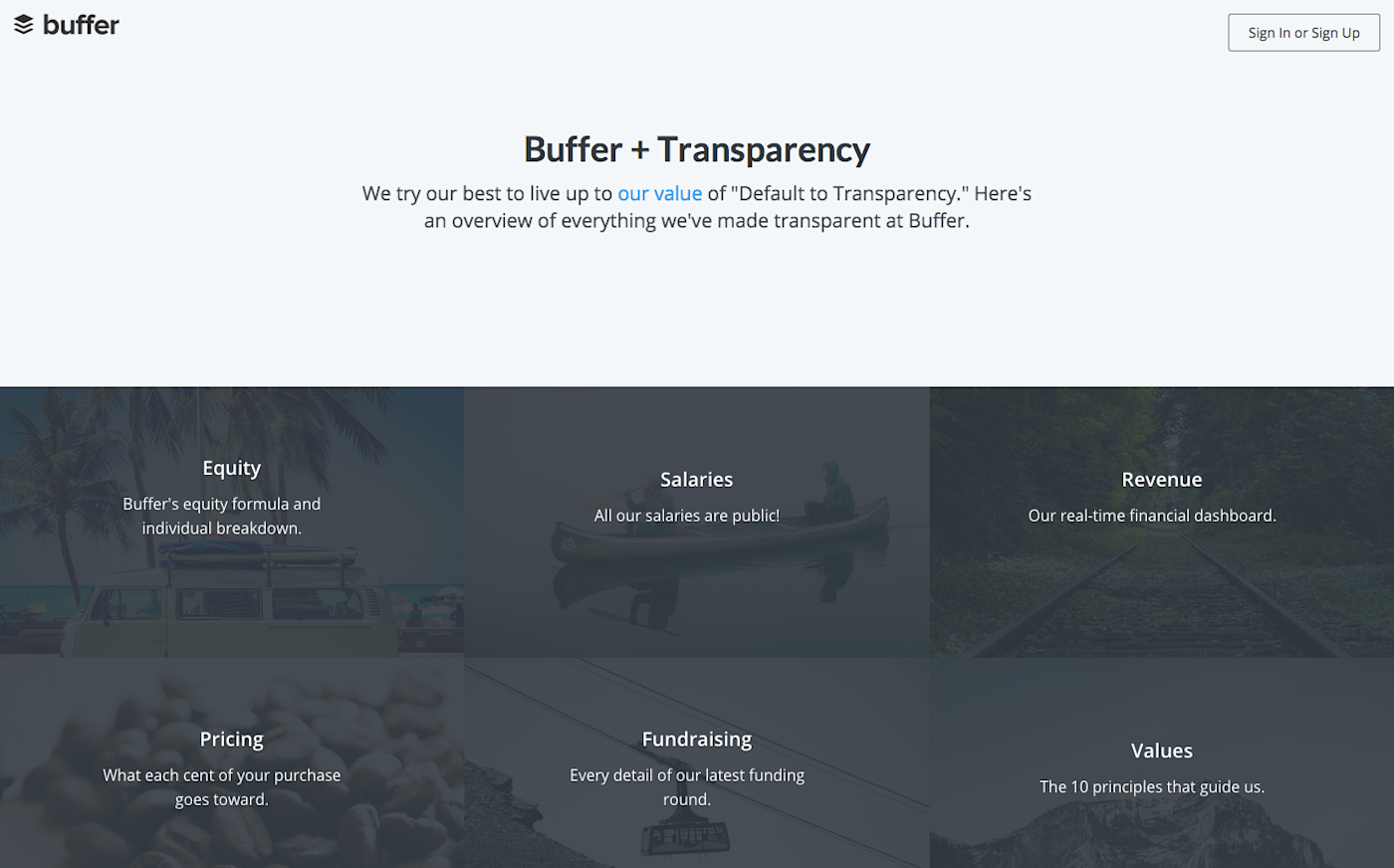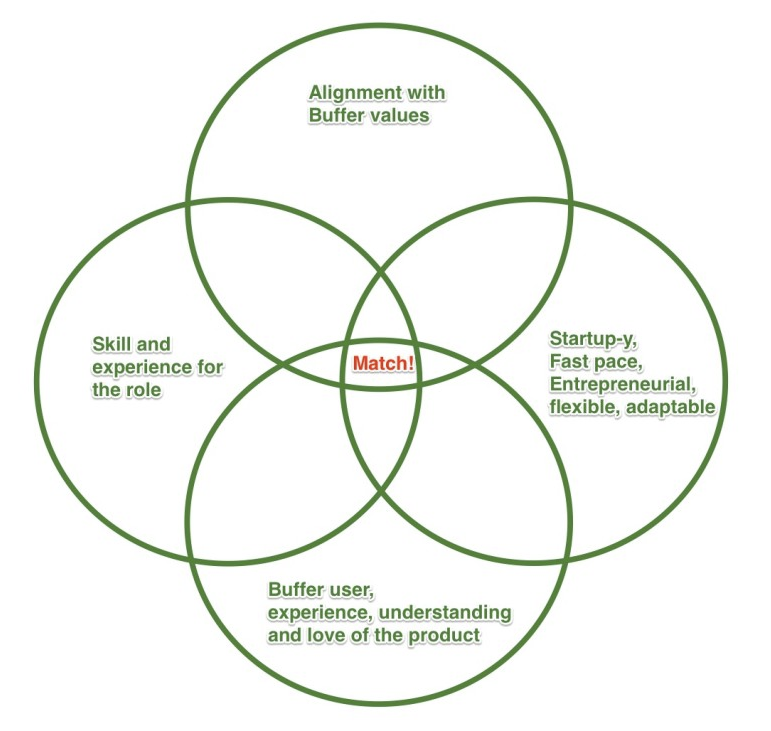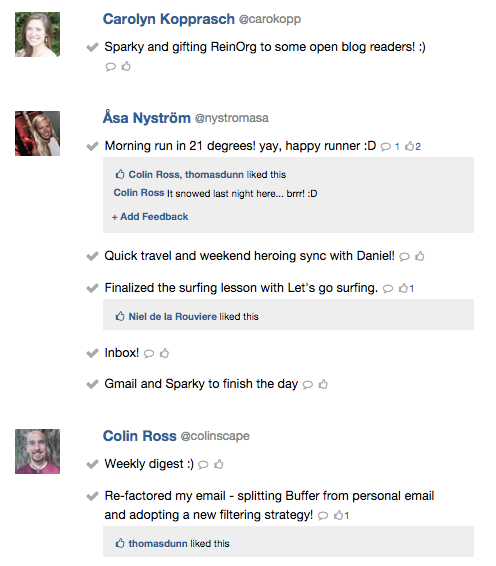Buffer has established themselves as the transparent company. Dozens of press articles—Inc., TechCrunch, Quartz and the San Francisco Chronicle for starters—along with posts on their own blog, document their concerted efforts to be transparent internally and externally. The startup behind the social media scheduling tool with the same name doesn't have much left to broadcast as it tries its hand at what some describe as radical transparency. Their latest move shows just as much, launching a page dedicated to everything they’ve made transparent.
As a former tech news editor, I think it's inspiring to see Buffer disclose employee salaries and equity, expose company financials, reveal how their customers’ payments are used and surface internal metrics—or more recently, restructure the company. But what if I wanted to replicate transparency inside a company of my own someday or encourage leadership I was working under to become more transparent? Where do I start? Where do they start? What's the key to making this work like Buffer?
Fortunately, as you might expect, Buffer is there to help with this, too. The startup's co-founder and COO Leo Widrich recently spoke with us about the leadership steps to creating a transparent, open company, or if you're part of a company, how to help your employer head in that direction. But before diving in to the process, let’s take a step back.
Transparency Before Buffer

Buffer's propensity toward transparency came from before the startup's own genesis. It began when Widrich’s co-founder, Joel Gascoigne, worked to gain momentum for his previous startup, OnePage. Though his idea for interactive contact cards didn't take off, he came away with something invaluable: the support of a dedicated group of followers there for the ups and downs he revealed on his blog. So when he tested the waters for Buffer’s viability, he had instant feedback from people who wanted to see him succeed.
When he and Widrich later started Buffer, they defaulted to transparency, which remains a company core value.
"It came to us very naturally, and at the very beginning we felt that generally the way we would approach building a company or anything in life—we want to be open about it," Widrich says. "I don’t think we ever perceived it as something we had to do. It was a way of being, a way to do things."
They’ve upped the ante since launching in November 2010. Now 31 employees strong and growing, there’s a whole lot more complexity and a lot of eyes on the champion of business transparency.
What is "Transparency," Anyway?

It’s important to know what you’re truly saying when you say "transparency." How Buffer defines it frames each action they take, and may help you define yours.
"When we first started doing things, the original understanding we had was to put everything in people’s faces. ‘Here’s everything we do and know everything in the first minute you interact with us,’" Widrich says.
"What it means now: someone within Buffer has the trust and the ability to learn and to access any piece of information conveniently and easily at any point of time that they want to."
Though that doesn’t mean they’ve figured it all out quite yet.
"There’s a lot of room within that definition," he says. "When do you put something into the back folder that people can check on and when do you put something front and center? Those are the things we’re trying to figure out now."
Companies of every size and industry are taking a long look at transparency and attempting to define it as only they can.
Square holds weekly "town square" meetings where any question can be asked and notes about every meeting are sent out to all employees
SumAll makes everything internally transparent, including salary, ownership stake in the company, transactions between partners and dealings with financiers
Qualtrics has a system of company-wide objectives that everyone adds to and are available to all, including notes on every meeting and board meeting as well as weekly emails about what each person plans to get done
Whole Foods has opened salaries internally since 1986, stores post sales each day and regional sales data gets posted for everyone each week
ustwogames shares sales, revenue and development costs for their wildly successful game, Monument Valley
Indie rock group Pomplamoose, though not a company in the traditional sense, pulls back the curtain on Medium to talk about what it took to put on a tour and why they hadn’t quite "made it"
As stated earlier, Buffer hasn’t left many stones unturned. In one centralized location the public can find links to how every cent is spent if you’re a customer, all of the startup's revenue in real time, each team member’s salary and the formula to determine it, a breakdown of equity for each employee and details of their venture capital financing.
I’ll let you dig into the bevy of resources there, but what about those steps to success you can put to work today?
First, See Where You Stand
Before you dive in, Widrich recommends a full embrace of the concept.
"Going half way can be dangerous," he says. "If you go only some way with it, it still leaves the door to mistrust, to a toxic environment. The question poses itself, ‘Why is that not transparent? We make everything transparent but salaries.’ And then everyone starts to wonder. Because they’ve tasted transparency on other levels, they’re going to be very aware of it.
"When questions don’t get answers, they make assumptions. They make up their own answers. People fill the gaps of what’s not transparent. And that’s where the danger lies."
How to Bring Transparency to Your Company
1. Check Yourself: Are You Personally Transparent?
If someone asks you what your salary is right now, are you reluctant to share that?
OK, now that the groundwork has been laid, Widrich recommends starting with a simple—yet potentially challenging—test, particularly for founders and C-level leaders.
"Do you share with friends openly? If someone asks you what your salary is right now, are you reluctant to share that?"
If you hesitate, Widrich recommends further soul searching and reflection before you continue to the next step. If you’re confident you would, that doesn’t mean you’re ready to disclose salaries, but you’re off to a great start.
"What’s most important is your mindset… that sharing things with others, keeping few or no secrets, is the right thing to do," he says.
Maybe just as crucial is putting your worries to bed. The temptation often arises and Buffer gets a lot of feedback asking whether they’re worried about letting the cat out of the bag, so to speak.
"The biggest fear is that ‘someone will steal our secrets,’" Widrich says. "Competition is a word I hear a lot. Not everyone is copying you. Everything keeps on going… more of an emotional learning, dealing with your fear. Really exploring your emotions first."
2. Be Sure Other Company Values are in Place

You’ve passed the first test and are raring to go, ready to become the next leader in workplace transparency.
But the best way out of the gate is to make sure your company already has an identity along with culture and values in place. A policy of transparency alone will almost always brew disaster.
"Sometimes people see us and say, ‘We’re going to pick that transparency out and apply it to our company.’ I think that can be dangerous and at times ill advised," he says. Instead, identify ways transparency is already embraced.
"It lines up with our values. We have a value of positivity. We have a value of self-improvement. We have values around listening. So a lot of these other values are interlinked with transparency," Widrich says. "It’s more like, 'I’m going to take a step back. Who are we? What do we want to do? What are our values? What do we want to achieve?'"
3. Hire with Transparency in Mind
Buffer takes hiring very seriously as they look for fun, passionate people—yep, they’ve documented that, too. Every potential employee goes through a 45-day boot camp with the team. And they need to go to great lengths: Buffer received 4,000 applications the month it publicly disclosed salaries.
Widrich makes the poignant point that as humans we spend 50 percent of our waking lives with our co-workers, so they better be people we’re really excited about and "not just someone who can bring you performance and results."
The team checks how well each candidate matches four areas, which he says narrows the field very quickly: values, experience in a fast-paced environment, a Buffer user and skills.

More than skills or experience, Widrich says Buffer places an emphasis on fit. And his advice is ready for any company to run with when looking at a candidate for traits like empathy, gratitude and positivity:
On that first application - How much do they talk about themselves? How much do they talk about your company?
Read their social accounts - Read up on their Twitter account and any other social media accounts. Do they seek out the positive or the negative in the world?
In the interview and trial/boot camp phase - How happy are they? Have they reinvented themselves and picked up new skills? How much do they complain?
4. Start Slow and Steady

You have a team that believes in the mission and embraces the company’s values. Now you’re ready to start slowly opening up internally and externally.
Start with your blog traffic or something far less crucial than revenue to divulge to the outside world. Ease into it, Widrich says. Or better yet, find ways to be more transparent to your team. You might make signup statistics or financials available to everyone and loop the team into important emails—anything that had previously been kept to a small group.
"The most important realization people often have is that the world doesn’t explode and all of a sudden go crazy, but actually things still work as normal," he says. "Then you build that trust and learn you can do more."
As you go, bring the team into the process when the time is right. Months before Buffer salaries went public—they had been disclosed internally since the early days—Gascoigne sent an email to the team (pictured) asking if anyone had input or concerns. There were some who did, and he made sure to have individual conversations with all of them to understand their issues and how he could address them.

5. Equip Yourself with Tools for Transparency

There are endless app and software options for the workplace, but Widrich points to a few he'd recommend to any company trying to implement structure for transparency. He does, however, leave the caveat that having a remote team is an advantage for Buffer’s efforts. It’s a lot easier to record a conversation from afar or to make an email transparent.
"A lot of communication happens on things that are easy to be made transparent," he says. "If you’re all in one room, even if I want to be transparent and I talk with you one-on-one, it’s by default not transparent."
That said, there's a lot of value here for any founder interested in opening things up. Before you think about any big campaign to open your company to the world, here are tools to make day-to-day interactions more transparent:
HipChat - A place for team communication. Where they spend most of their time together, and most of their discussions happen in group chats that are public.
Trello - A project management tool and to-do list to keep track of individual and team progress. All Buffer boards are completely transparent to everyone in the team.
Sqwiggle - A video chat tool that lets you see what your team is up to with updated screenshots every few minutes. It helps them see who is having calls or is busy at the moment.
iDoneThis - Precisely what it says, it's a tool that lets the team send in what they’ve done and then receive a morning email showing everything being worked on.
Hackpad - A place to jot down notes and collaborate. It allows them to flesh out ideas, see what each other is working on and add to those ideas easily.
Email - The Buffer team has an extensive system for how they handle them, but the gist is that they try to include people earlier so no one is late to the conversation.
Facebook - They have a private group for Buffer employees and their families to share everything going on in their lives.
Jawbone UP - A fitness and sleep tracker. Everyone gets one when they start and they’re encouraged to use it to show how they're doing outside of work, whether it’s hours of sleep or steps taken.
Kindle - Anyone can request a book for free through a web form, which then shows up in the team Facebook group so everyone can see what everyone is learning and reading.
6. Remind Yourself: Transparency isn't for Everyone
If you're able to go through all of that, implement changes and start building a culture of honesty, then you've succeeded by almost all accounts. But it may not always be the prettiest transition, which is OK.
"Once you’ve done the initial lightweight changes, it will probably not work for a lot of people," Widrich says. "There will be friction. Expecting that and knowing that’s going to happen, you have to be convinced that it’s worth going through."
If you’re reading this and you aren’t a founder or executive at your company, your pleas for change may not always translate, Widrich says, and it may be time to move on.
"It has to come from someone who has meaningful influence. That might not be satisfying to a lot of people. But if it’s not the CEO or one of the founders or someone higher up compelled to make that change, I think someone is better off to find a different organization that is more inclined to make that change."
The (Potential) Benefits of Transparency

The rewards to all of this hard work are hard to predict and probably shouldn’t be a focus, according to Widrich.
Buffer’s story is an outlier for all the press—here included—it’s generated for a radical brand of transparency they’ve shouted from the rooftops. But that doesn’t mean you won’t see major benefits from building out a culture that embraces transparency. A few of the reasons to go for it, from Buffer’s experience, include:
Efficiency - The awareness among the entire team of what is happening with the company on all levels allows everyone to pitch in where it makes the most sense. A clearly defined set of values paired with transparency means you’ll be looking for very specific candidates, easing the often-painful hiring process.
Loyalty - From employees, customers and potential hires, honesty and information creates a relationship that makes them more invested. Buffer's largest signup days and biggest application batches have come when it's released transparency posts on fundraising, revenue and salaries.
Greater trust - As mentioned before, your team is going to fill the gaps of info it doesn’t know. If they know that info, it’s easier to get behind the company’s mission.
Reduced stress - When employees know where they, their co-workers and the company stand at all times, there’s far less uncertainty.
And…
An Environment of Workplace Equality
I did a fun little Q&A with @careerbliss about Buffer's open salaries: What if Everyone at Work Knew Your Salary? http://t.co/b2Fx42ZAjz
— Courtney Seiter (@courtneyseiter) April 11, 2014
Widrich says one of the most rewarding moments in his career and a validation of Buffer’s transparency was a female co-worker's tweet (above) linking to a blog post about salary negotiation where she said she was grateful to be at Buffer for its open policies. In the interview, Courtney Seiter, Buffer's head content crafter, had this to say:
When salaries are open, women don't have to be worried about making less than men. Minorities don't have to wonder if they're being treated fairly. I truly believe Buffer's transparent salary formula creates a "level playing field" model that is needed in many places around the world.
Equal pay for women in the United States is a consistent hot topic, but it’s especially timely and complex in the tech industry. So is salary disclosure the answer?
"Yes, I do think so," Widrich says. "I believe pay transparency could cure equal pay completely. Of course, there might be other issues that could arise by just ‘dumping’ pay transparency into a company, like we've talked about before. But yes, I do think this would be a major win. Equal pay is not a part of any of our meeting discussions simply because salaries are transparent. It would be absolutely insane to pay anyone in the same position something different."
So Where Do We Go From Here?
It’s a wild time for transparency and it’s hard to see who will implement radical changes and what the business landscape will embrace. What’s clear is that Buffer has no intention to slow down or stop opening more doors, turning over more stones.
Widrich says they have two major frontiers left (as of now).
Feedback is the only thing that’s not transparent within Buffer. All communication still remains between the two parties. They noticed people stop giving as much feedback when it’s put out to everyone, so they're discussing ways to potentially open up company-wide inclusion after initial contact between two people. The ball would then be in the court of anyone who received feedback to open up to everyone.
The other is hard to comprehend. They’re tossing around the idea to open up every morsel of info at Buffer, including product development, so the public could see the entire process.
"Someone sent a tweet, ‘Why not make email completely transparent even to the public? What if everyone in the world could see all the emails being sent at Buffer all the time?" Widrich says. "That’d be really interesting to explore as a thought experiment. What if every single thing we were working on was completely transparent?"
Is there a line in the sand for how far Buffer will go with transparency?
"We’re trying to find that line right now," Widrich says. "Maybe our login details to our bank account. That might be something we might not want to put out there. But maybe there is some way to do that. [Laughs] But no, not that I’m aware of."
Transparency in Action: My Disclosure
As we wrapped our phone interview, Leo suggested I include the audio recording for full disclosure. I loved the idea, but felt that would only be going half way. Plus, it’s hard not to pick up transparency fever after browsing through dozens of articles advocating its value and hearing the passion Leo has for it.
So, for full disclosure:
I was paid $375 to write this article, which is around 3,250 words in length.
It took me about 16 hours to do all of the interviewing, reading, researching, transcribing, writing, editing and re-reading.
I received this writing gig because I was a reporter at Silicon Prairie News when Zapier’s Danny Schreiber was managing editor.
Danny assigned this topic to me because Buffer is one of the Zapier's integration partners, which they like to highlight on their blog.
Here’s the audio from my interview with Leo. He’s a bit quiet as I was recording him from a Google Hangout on my computer to my phone. The first 25 seconds were awful scratching, so I cut those out. Also, it’s always incredibly painful to hear my voice in a recording.
Here are my transcription notes.
Here’s the Google Docs draft of revisions.
How Buffer uses Zapier

Related: Zapier is among the tool set that Buffer pays for each month, revealed in their post "Introducing Transparent Pricing: What Your Money is Used for When You Purchase a Buffer Subscription". Here are two Zapier automations they find valuable along with one of the most popular Buffer integrations on Zapier:
Credits: Buffer photos, screenshots and graphics courtesy Buffer.





